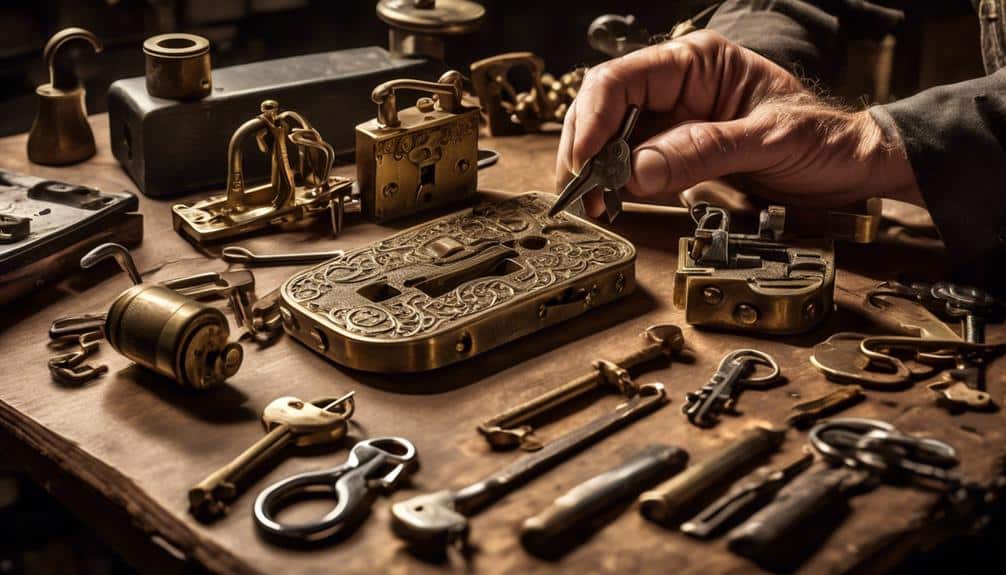Have you ever found yourself holding an antique lock key, marveling at its intricate design and curious about its history? Well, let me tell you, duplicating antique lock keys is like embarking on a treasure hunt.
Each step is like peeling back layers of time, revealing the secrets of these beautiful relics. But don't worry, we're here to guide you through this fascinating process.
From gathering the necessary tools and materials to troubleshooting common challenges, we'll provide you with a comprehensive step-by-step guide.
So, come along with us as we unlock the world of duplicating antique lock keys, and discover the satisfaction of preserving history in your hands.
Gathering Necessary Tools and Materials
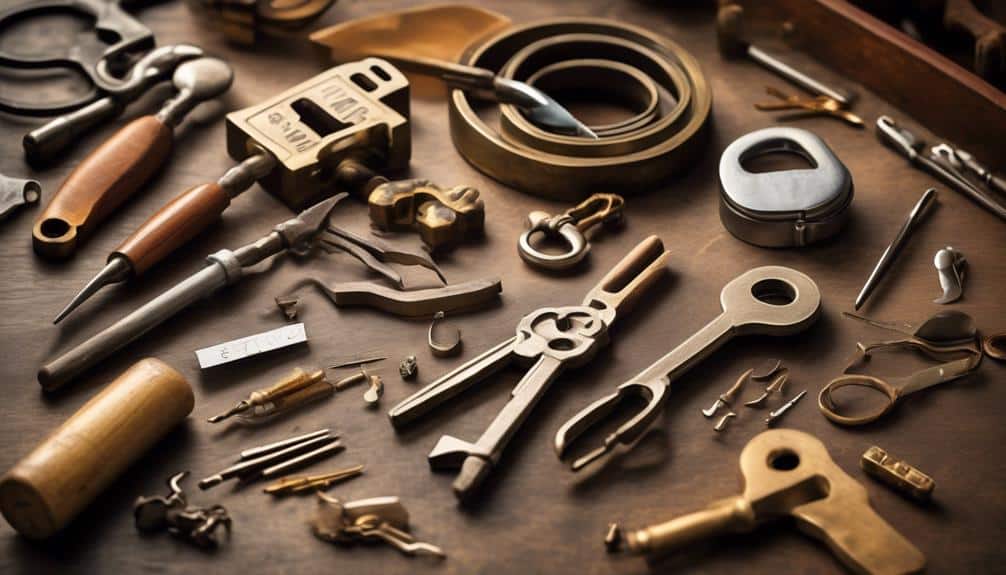
To gather the necessary tools and materials for duplicating antique lock keys, we'll need to acquire a few specific items. The key duplication process requires precision and attention to detail, so it's crucial to have the right tools at hand.
The first tool we'll need is a key duplicator machine, which is specifically designed for replicating keys. This machine uses a cutting wheel to carefully carve the key's shape into a blank key. It's essential to choose a key duplicator machine that's suitable for antique lock keys, as they often have unique designs and intricate details.
In addition to the key duplicator machine, we'll also need a selection of blank keys. These blanks should be made of high-quality metal and have the appropriate size and shape for the specific antique lock keys we're duplicating. It's important to use blanks that closely match the original keys to ensure a precise duplication.
Furthermore, we'll require a set of key files to fine-tune the duplicate keys. Key files come in various sizes and shapes, allowing us to shape the duplicate keys to perfection. These files have different cutting surfaces, which allows for precise adjustments and ensures that the duplicate key fits smoothly into the lock.
Examining the Antique Lock and Key
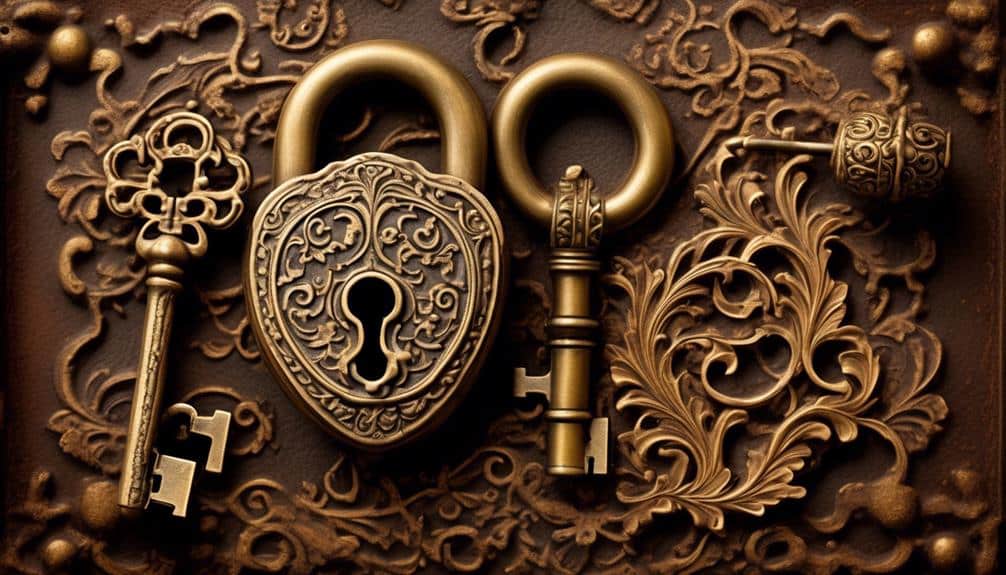
Having gathered the necessary tools and materials for duplicating antique lock keys, we can now move on to examining the antique lock and key in order to understand its intricacies and ensure an accurate duplication process.
When examining the antique lock and key, it's important to pay attention to the following details:
- Key Construction:
- Carefully analyze the key's construction to determine its type and design.
- Look for any unique features or markings that may indicate its origin or manufacturer.
- Measure the key's length, width, and thickness to ensure the accurate reproduction of its dimensions.
- Key Wear Patterns:
- Examine the key for any signs of wear or damage.
- Pay close attention to the teeth of the key, as they can provide valuable insights into the lock's mechanism and the key's usage history.
- Look for patterns of wear that may indicate the most frequently used teeth.
- Lock Mechanism:
- Study the lock to understand its inner workings.
- Take note of the type of lock, whether it's a lever lock, pin tumbler lock, or another variety.
- Observe the size and shape of the keyhole, as well as any additional features that may affect the key's operation.
- Material and Finish:
- Evaluate the key's material composition and finish.
- Determine whether it's made of brass, iron, or another metal, and note any signs of corrosion or patina.
- Consider the key's aesthetic qualities, such as engravings or decorative elements, which may be important to replicate accurately.
Identifying the Key Type and Design
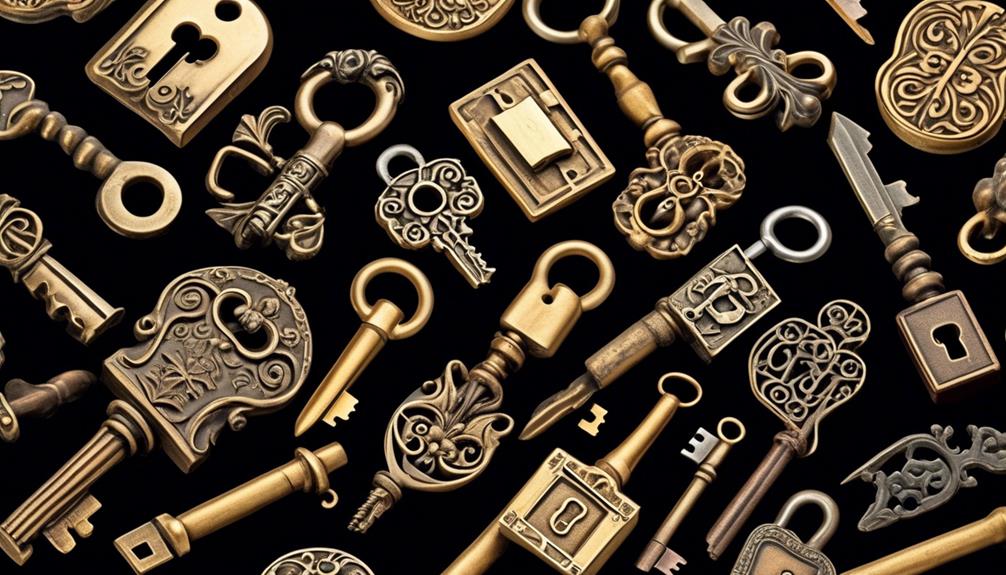
In order to accurately duplicate an antique lock key, it's crucial to first identify the key type and design through careful examination and analysis. This process involves identifying key markings and researching key manufacturers to determine the specific characteristics of the key.
When examining an antique lock key, it's important to look for any markings or engravings on the key itself. These markings can provide valuable information about the key type and design. Key markings may include the manufacturer's name or logo, the key's serial number, or any other identifying information. By identifying these key markings, you can begin to narrow down the key's origins and potential manufacturers.
To further refine your understanding of the key type and design, it's essential to conduct thorough research on key manufacturers. Many manufacturers have distinctive key designs or patented features that can help in identifying the key type. By researching key manufacturers, you can gain insight into their specific key designs and determine if the key you're examining matches any known designs or patterns.
Selecting the Appropriate Key Blank
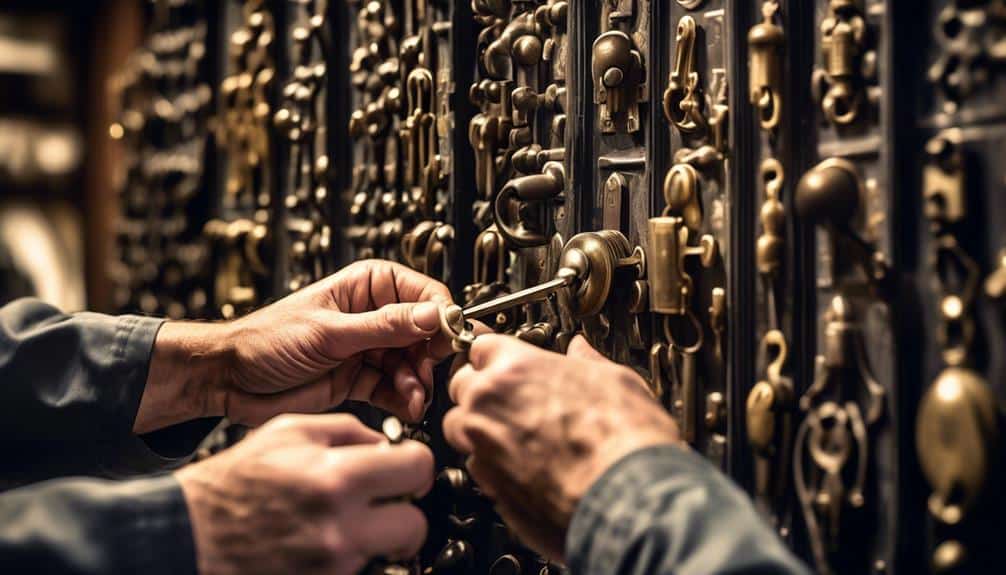
When it comes to selecting the appropriate key blank for duplicating antique lock keys, there are a few key points to consider.
First, you need to be aware of the different key blank options available and choose one that matches the type and design of the antique lock.
Additionally, it's crucial to ensure that the key blank you select is compatible with the specific lock you're working with.
Taking these factors into account will help ensure a successful duplication process.
Key Blank Options
To ensure accuracy in duplicating antique lock keys, it's essential to carefully select the appropriate key blank. The key blank material and size are crucial factors to consider when choosing the right blank for duplication. Here are the key blank options you should know:
- Key Blank Materials: Key blanks are typically made of brass, steel, or nickel silver. Each material has its own characteristics, such as durability and resistance to corrosion. It's important to choose a key blank material that matches the original key to ensure a proper fit and function.
- Key Blank Sizes: Key blanks come in various sizes and profiles. It's essential to select a key blank that matches the original key's size and shape. This includes considering the length, width, and thickness of the key blank. Using the wrong size can result in a key that doesn't fit into the lock or operates poorly.
- Compatibility: Ensure that the selected key blank is compatible with the specific lock mechanism. Different locks require different key profiles, such as pin tumbler or wafer locks. Make sure to choose a key blank that matches the lock mechanism to ensure successful duplication.
- Quality: Consider the quality of the key blank. Look for well-known and reputable manufacturers to ensure that you're using a high-quality blank. Cheaper, low-quality blanks may not be as durable or precise, leading to issues with key duplication.
Matching Antique Locks
After carefully considering the key blank options, it's now crucial to ensure that the selected key blank is a suitable match for the specific antique lock being duplicated. Matching antique keys to preserve antique locks requires precision and attention to detail.
The key blank must be compatible with the lock's internal mechanisms, ensuring a smooth and accurate duplication process. To achieve this, it's essential to examine the original key and the lock itself. Look for unique features, such as notches, grooves, or patterns, that distinguish the key and the lock from others.
Select a key blank that closely resembles these distinctive characteristics. By using the appropriate key blank, you can preserve the integrity of the antique lock while creating an accurate duplicate key.
Key Blank Compatibility
Now that we've examined the original key and lock for unique distinguishing features, it's imperative to carefully select the appropriate key blank to ensure compatibility with the antique lock's internal mechanisms. Key blank compatibility is crucial for successfully duplicating an antique lock key.
When selecting a key blank, consider the following key blank options:
- Size and shape: The key blank should match the size and shape of the original key to ensure a proper fit into the lock.
- Keyway: The key blank should have the same keyway profile as the original key to ensure that it can smoothly enter and turn within the lock.
- Material: Choose a key blank made from a durable and corrosion-resistant material to ensure longevity.
- Manufacturer compatibility: Some antique lock manufacturers may have specific key blank requirements. Research the manufacturer's guidelines to select the appropriate key blank.
Creating a Key Impression
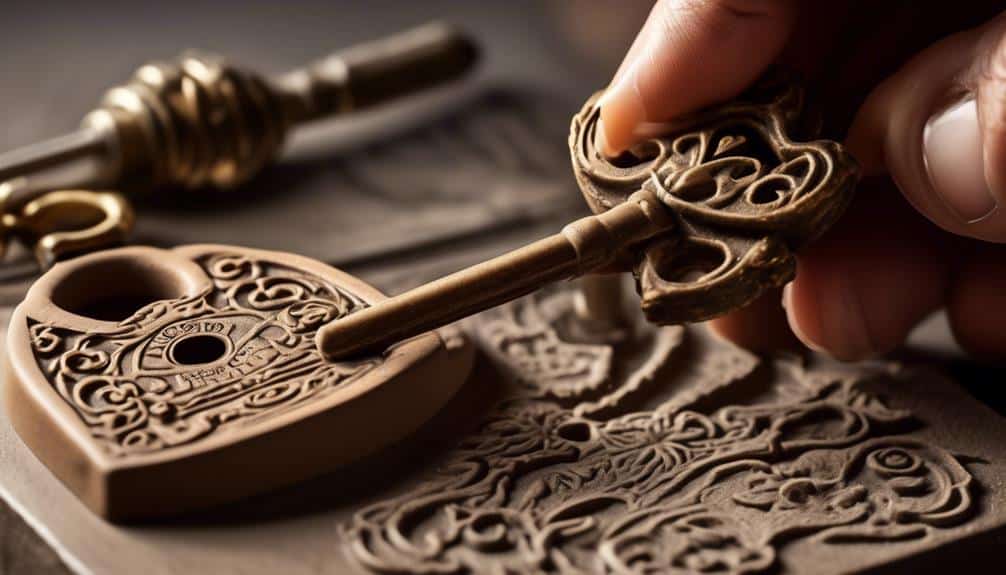
Creating a key impression is an essential step in duplicating antique lock keys. This process involves using specialized tools to create an imprint of the key's unique shape and cuts. By carefully manipulating the key blank against the lock, we can capture the necessary details to reproduce an accurate duplicate.
However, troubleshooting may be required if the key impression doesn't yield the desired results, requiring a thorough examination of the tools and technique used.
Key Impression Process
To initiate the key impression process, we can optionally employ a quantifier determiner to accurately capture the intricate details of the antique lock key. This step is crucial in ensuring a precise duplication of the key.
Here is a step-by-step guide on how to create a key impression:
- Clean the antique lock key thoroughly using a solvent and a small brush to remove any dirt or debris that may affect the impression quality.
- Apply a thin layer of graphite powder to the key, ensuring that all surfaces are evenly coated. This will help enhance the visibility of the key's grooves and ridges.
- Insert the key into the lock and turn it slightly to engage the pins. Be careful not to apply excessive force, as this may damage the key or lock.
- Slowly remove the key from the lock, making sure to maintain the position and orientation. This will allow the impression material to capture the key's detailed features accurately.
Tools for Key Impression
We can employ specialized tools to create a key impression, ensuring an accurate reproduction of the intricate details of the antique lock key. These tools are designed to capture the exact shape and dimensions of the original key, allowing for the creation of an identical duplicate. Key impression techniques involve using a key impressioning kit that typically includes a blank key, impressioning putty, and a key gauge. The process begins by applying the impressioning putty onto the original key's blade, making sure it covers the entire surface. Once the putty hardens, it is carefully removed and placed onto the blank key. By gently pressing the two keys together, the impression is transferred, revealing the precise cuts and notches required to create an accurate duplicate.
| Tool | Purpose | Example |
|---|---|---|
| Key Impression Kit | Contains tools needed for key impressioning | Impressioning Kit |
| Impressioning Putty | Captures the shape and dimensions of the original key | Silicone-based putty |
| Key Gauge | Measures the depth and spacing of key cuts | Depth and Spacing Gauge |
Key impression troubleshooting may be necessary if the initial impression does not produce satisfactory results. Troubleshooting techniques include ensuring proper alignment and pressure when pressing the keys together, as well as using additional putty to create a more accurate impression. It is also important to check for any obstructions or debris in the keyway that may affect the impression. By carefully following key impression techniques and addressing any troubleshooting issues, we can ensure a successful reproduction of the antique lock key.
Troubleshooting Key Impressions
After completing the key impression process using the key impressioning kit and specialized tools, it may be necessary to troubleshoot and address any issues that arise to ensure an accurate reproduction of the antique lock key. Troubleshooting key impressions can help overcome common duplication challenges.
Here are four common issues and their solutions:
- Incomplete or faint key impression:
- Check that the key blank is properly aligned and seated within the keyway.
- Apply gentle but firm pressure when making the impression to ensure a clear and accurate imprint.
- Uneven or distorted key impression:
- Check if the key blank is slipping or moving during the impression process.
- Make sure the keyway is clean and free from debris that may affect the impression.
- Use steady and consistent pressure when creating the impression.
- Incorrect depths or spacing:
- Verify that the key blank is properly aligned and centered within the keyway.
- Adjust the pressure or angle when creating the impression to achieve the desired depths and spacing.
- Key impression doesn't fit the lock:
- Double-check the original key and compare it with the impression.
- Look for any discrepancies in the pattern or depths.
- Make adjustments to the impression as necessary, ensuring a precise fit.
Transferring the Impression to a Key Blank
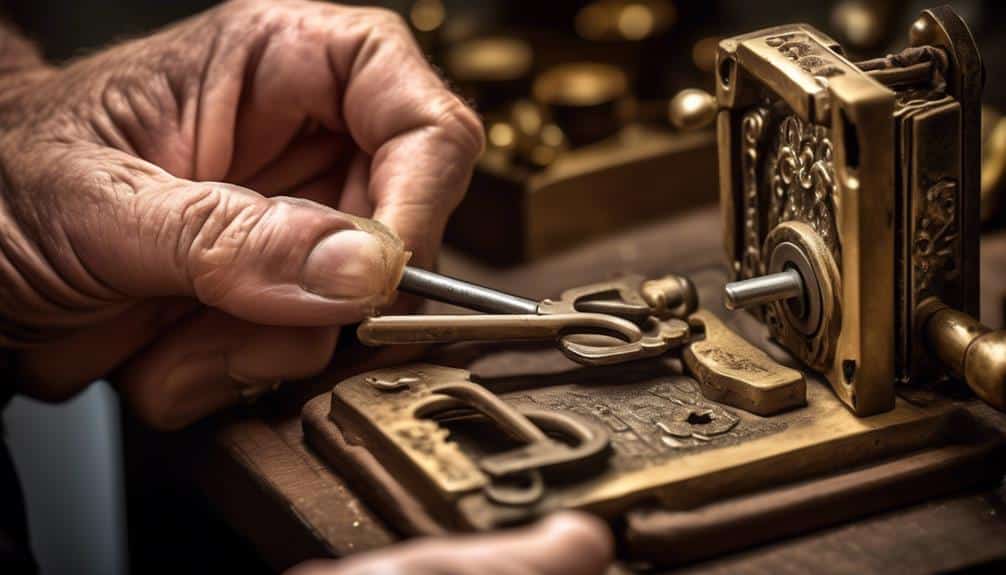
Using a specialized key duplicating machine, we carefully transfer the impression from the original antique lock key to a blank key. This step is crucial in the process of duplicating antique lock keys accurately.
However, there are potential challenges and troubleshooting techniques that may arise during this stage.
One common challenge faced during this process is ensuring that the impression is accurately transferred to the blank key. If the transfer isn't precise, it can result in a key that doesn't fit or function properly. To troubleshoot this issue, we carefully examine the transferred impression for any inconsistencies or imperfections. By using a magnifying glass and proper lighting, we can identify any areas that require adjustment.
Another key duplication challenge that may arise is the compatibility of the blank key with the original lock. Antique locks often have unique keyway profiles, which means that finding a suitable blank key can be difficult. In such cases, we may need to modify a blank key by filing or grinding it to match the keyway profile of the original lock.
Shaping the Key Blank to Match the Original Key
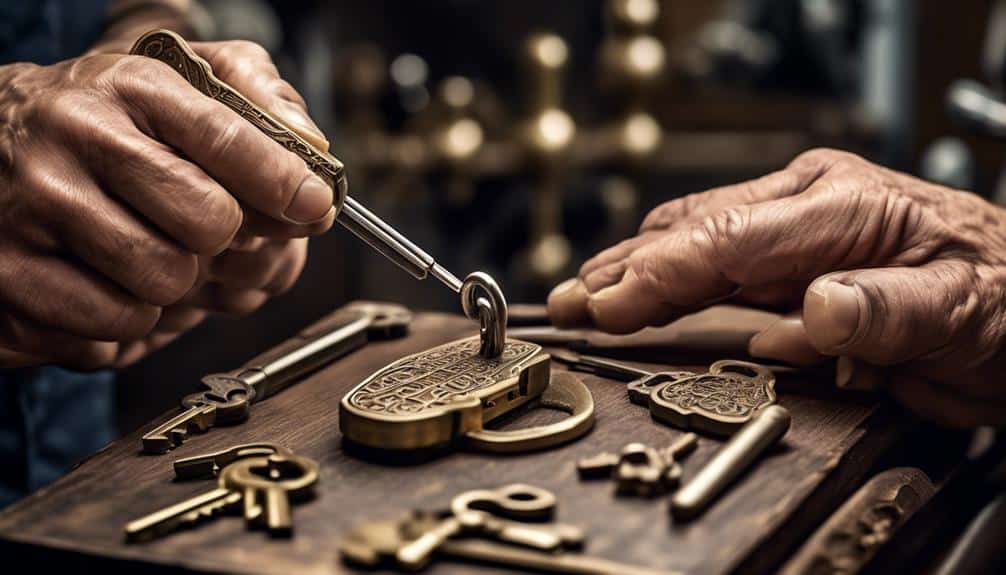
To accurately shape the key blank to match the original key, precise measurements and careful filing techniques are employed. This crucial step ensures that the duplicate key fits seamlessly into the lock and operates smoothly. Here is a step-by-step guide on key blank shaping and key duplication techniques:
- Measure the original key: Using a caliper or a precision ruler, measure the length, width, and thickness of the original key. Take note of any unique features or notches.
- Select the appropriate key blank: Choose a key blank that closely matches the measurements of the original key. It should have the same length, width, and thickness. Opt for a blank that also has similar notches or grooves.
- File the key blank: Using a fine-toothed file, carefully shape the key blank to match the original key's profile. Start by filing the flat side of the blank to match the width and thickness. Then, slowly file the notches, ensuring they align perfectly with the original key.
- Test the duplicate key: After shaping the key blank, test the duplicate key in the lock. It should smoothly turn the lock mechanism without any resistance or sticking.
Filing and Sanding the Key for a Smooth Finish
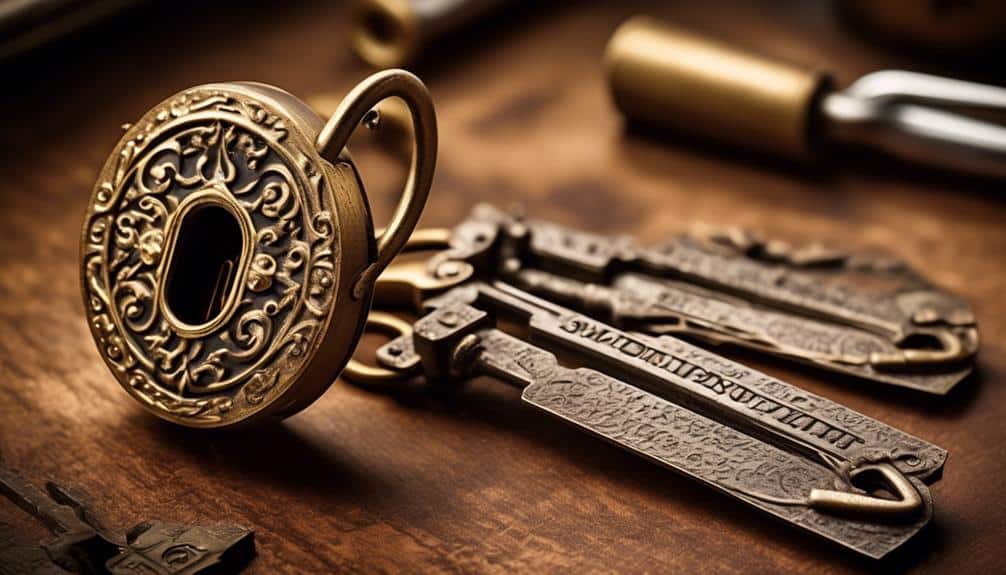
With the key blank now shaped to match the original key, the next step in duplicating antique lock keys involves filing and sanding the key to achieve a smooth and polished finish. Filing techniques are crucial in removing any excess material and refining the key's shape. A flat file is commonly used, held at a slight angle to the key's surface, moving back and forth in smooth, controlled strokes. The file should be used with care to avoid removing too much material. It's important to check the key's fit frequently, ensuring that it continues to align with the lock properly.
After filing, sanding methods are employed to further refine the key's surface. Fine-grit sandpaper is used in a back-and-forth motion, working progressively from coarse to finer grits. This process removes any remaining roughness and imperfections, resulting in a smooth finish. Wet sanding can also be utilized, using water or a lubricant to minimize heat and friction, providing a smoother surface.
Throughout both the filing and sanding processes, attention to detail is crucial. The key should be constantly examined for any irregularities or rough spots, which can be corrected by applying additional filing or sanding as needed. By employing proper filing techniques and sanding methods, the key can be transformed into a polished masterpiece, ready for use in antique locks.
Testing the Key in the Lock
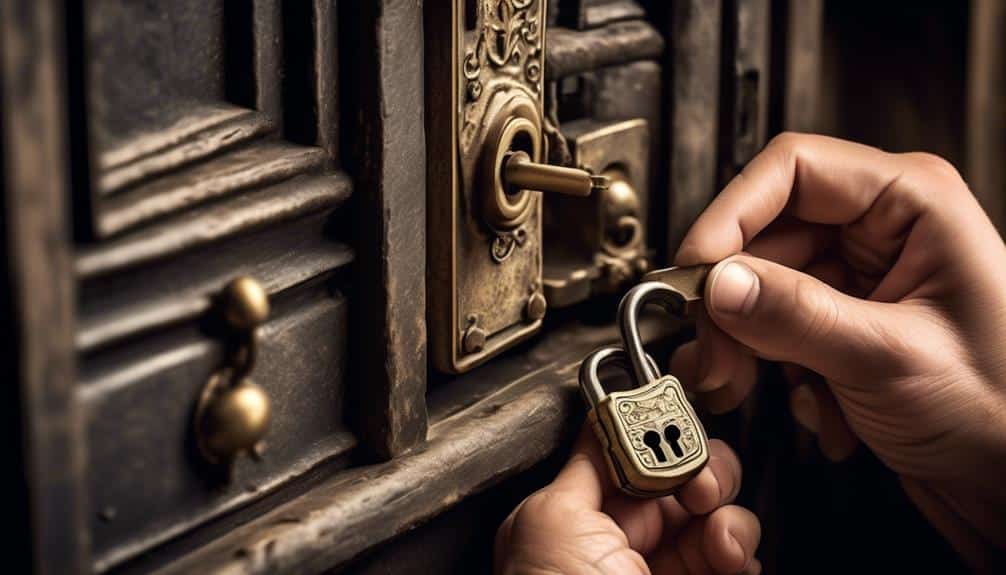
We must now evaluate the functionality of the duplicated key by inserting it into the corresponding antique lock. Testing the accuracy of the key is crucial to ensure that it operates smoothly and efficiently.
Here are some steps to follow when testing the key in the lock:
- Insert the key: Gently insert the duplicated key into the lock and ensure that it goes in smoothly without any resistance. If there's any difficulty in inserting the key, it might indicate a misalignment or an issue with the key's shape.
- Turn the key: Slowly turn the key in the lock, applying gentle pressure. The key should rotate smoothly without any sticking or jamming. If there's any resistance or the key gets stuck, it could be an indication of inaccuracies in the duplication process.
- Test the lock's functionality: Once the key turns smoothly, test the lock's functionality by opening and closing it multiple times. Ensure that the lock operates effortlessly and securely with the duplicated key.
- Consider alternative methods: If the duplicated key doesn't work as expected, you may need to consider alternative methods. This could include reevaluating the original key, adjusting the duplicated key, or seeking professional assistance.
Making Necessary Adjustments for a Proper Fit
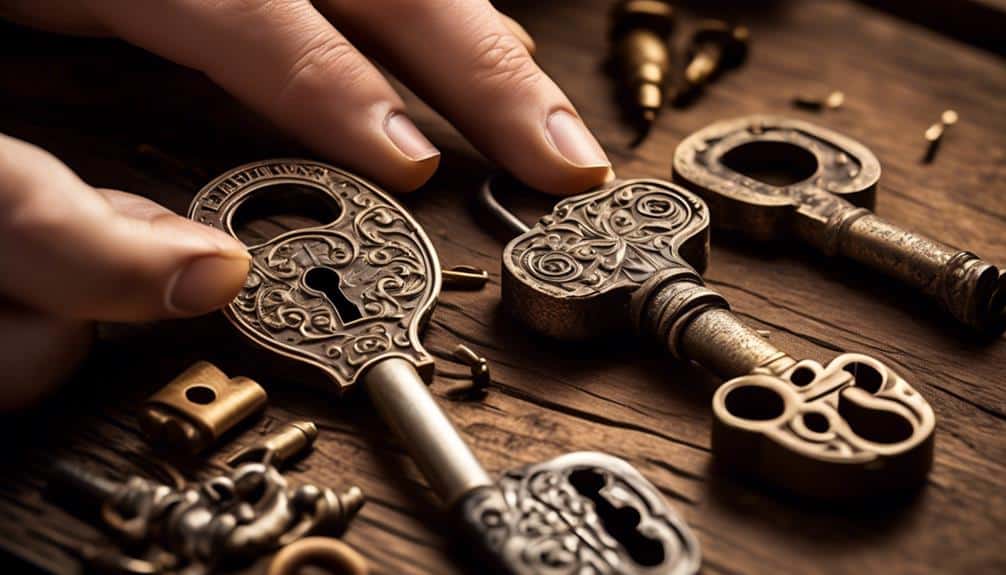
Now let's discuss the points that are crucial for making necessary adjustments for a proper fit when duplicating antique lock keys.
Firstly, key size and shape play a vital role in ensuring a precise fit, as even a slight variation can hinder the key's functionality.
Secondly, understanding the intricate mechanisms of the lock is essential in identifying the specific adjustments required for a perfect fit.
Lastly, having the right tools for precision adjustments, such as calipers and files, is imperative in achieving the desired outcome.
Key Size and Shape
To ensure a proper fit, adjustments to the size and shape of the key may be necessary, employing precise techniques and measurements. When it comes to key size analysis, it's crucial to accurately measure the length, width, and thickness of the original key. This information will guide you in determining the correct size for the duplicate key.
Key shape variations are also important to consider. Some antique locks may have unique key shapes, such as notches, grooves, or even intricate designs. Careful examination of the original key will help identify these variations and ensure that the duplicate key matches the original in both size and shape.
Understanding Lock Mechanisms
Understanding the intricate mechanisms of antique locks is crucial for making the necessary adjustments to ensure a proper fit when duplicating keys. By delving into the history of lock mechanisms and studying lock picking techniques, we can gain a deeper understanding of how these locks function and what adjustments may be required.
To illustrate this, let's take a look at a table that showcases different types of lock mechanisms commonly found in antique locks:
| Mechanism | Description | Adjustment Needed |
|---|---|---|
| Pin Tumbler | Consists of pins of varying lengths that must align to open the lock | Adjusting the key's pin height |
| Wafer Tumbler | Uses flat wafers instead of pins | Adjusting the key's wafer positions |
| Lever Tumbler | Employs levers that must be lifted to the correct height | Adjusting the key's lifting points |
| Disc Detainer | Relies on rotating discs to align | Adjusting the key's disc positions |
Tools for Precision Adjustments
Having gained a deeper understanding of antique lock mechanisms and the necessary adjustments for duplicating keys, we can now proceed to explore the tools required for precision adjustments to ensure a proper fit.
When it comes to precision calibration, the following tools are essential:
- Micrometer: This device allows for precise measurements of key dimensions, ensuring accurate replication.
- File Set: A set of fine files is necessary for making small adjustments to key shapes and sizes.
- Key Gauge: This tool helps determine the correct key blank to use by comparing it to the original key.
- Key Cutting Machine: A high-quality key cutting machine with proper tool maintenance is crucial for accurately cutting duplicate keys.
Maintaining the precision of these tools is essential for achieving accurate results. Regular cleaning, lubrication, and calibration checks are necessary to ensure their proper functioning.
Polishing and Cleaning the Duplicated Key
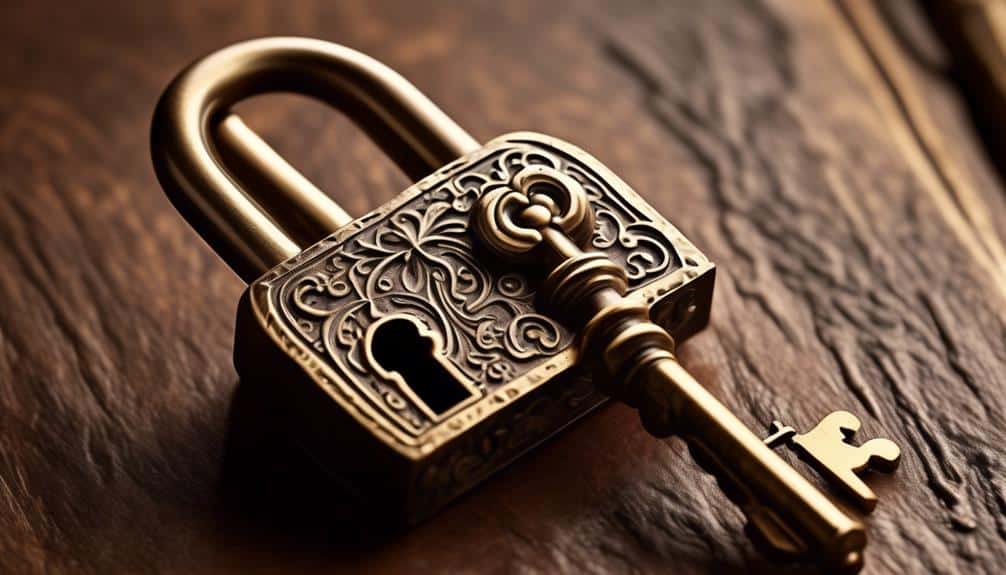
After duplicating the key, the next step is to carefully polish and clean it to ensure its optimal functionality and appearance.
Polishing is essential for removing any rough edges or imperfections that may affect the key's performance. There are various polishing techniques that can be used, depending on the material of the key. For brass keys, a soft cloth or polishing wheel can be used with a brass polish to gently buff the surface. Stainless steel keys may require a different approach, such as using a fine grit sandpaper or a polishing compound specifically designed for stainless steel.
Once the key has been polished, it's important to clean it thoroughly to remove any residual polishing agents or debris. Cleaning solutions can vary depending on the material of the key, but generally, a mild detergent or soap and water solution can be used. Care should be taken to avoid using abrasive cleaners or harsh chemicals that may damage the key's surface.
To clean the key, immerse it in the cleaning solution and gently scrub it with a soft-bristled brush. Rinse the key thoroughly with clean water and pat it dry with a soft cloth. It's important to ensure that the key is completely dry before using or storing it to prevent any moisture-related damage.
Applying a Protective Coating to the Key
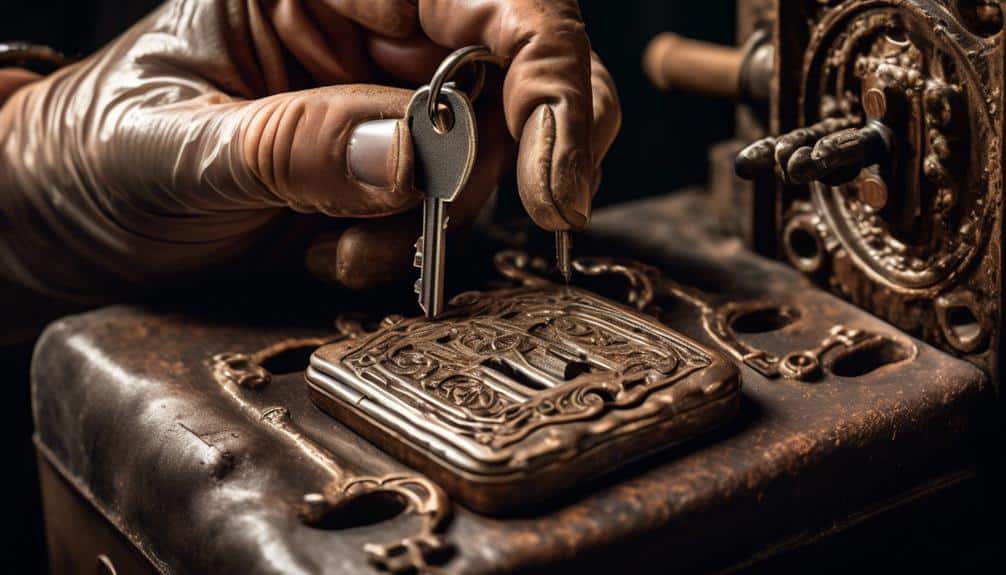
To ensure long-lasting durability and protection against wear and tear, it's important to apply a protective coating to the duplicated antique lock key. This step not only enhances the aesthetic appeal of the key but also helps to preserve its structural integrity.
Here are some key coating techniques to consider:
- Choose the right protective varnish: Select a high-quality varnish specifically designed for antique keys. Look for varnishes that provide a clear, durable, and non-yellowing finish.
- Clean the key thoroughly: Before applying the protective varnish, make sure the key is clean and free of any dirt, dust, or debris. Use a gentle cleaning solution and a soft cloth to remove any surface contaminants.
- Apply the varnish evenly: Dip a small brush or use a spray-on varnish to apply a thin, even coat over the entire surface of the key. Ensure that all nooks and crannies are adequately covered.
- Allow proper drying time: Follow the manufacturer's instructions for drying time. Avoid touching or handling the key until the varnish is completely dry to prevent smudging or damaging the finish.
Storing the Duplicated Key Properly
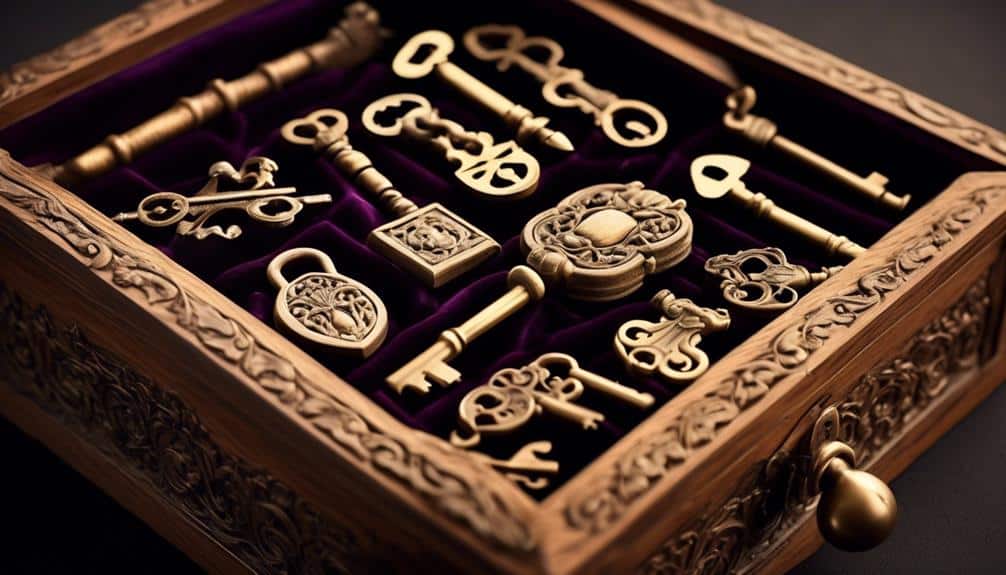
Now that we've successfully duplicated the antique lock key, it's crucial to discuss the proper way to store it.
There are various key storage options available, each with its own benefits and drawbacks.
The main goal is to prevent any damage to the key, as it's a valuable and delicate item.
Key Storage Options
For proper storage of the duplicated key, it's recommended to utilize key storage options that prioritize security and accessibility. Here are some key storage options to consider:
- Keychain options: A keychain is a convenient and portable way to keep your duplicated key with you at all times. Look for keychains with secure fasteners, such as carabiners or twist-lock mechanisms, to ensure that the key remains securely attached.
- Hidden key storage: If you prefer to keep your duplicated key hidden, there are various options available. You can choose from key hiders that resemble everyday objects, such as rocks or fake sprinkler heads, or opt for more sophisticated solutions like key safes that can be discreetly mounted on walls or disguised as electrical outlets.
- Lockable key cabinets: If you have multiple keys to store, a lockable key cabinet can provide a secure and organized solution. These cabinets often feature numbered hooks or key slots for easy identification and access.
- Electronic key storage systems: For enhanced security and access control, electronic key storage systems are worth considering. These systems typically require a PIN or biometric authentication to retrieve the key, providing an extra layer of protection against unauthorized access.
Preventing Key Damage
Properly storing the duplicated key is crucial to prevent any damage or loss. To ensure the key's integrity is maintained, it should be stored in a secure and controlled environment.
One option is to use a key storage box or cabinet, designed specifically for this purpose. These boxes are often equipped with individual compartments or hooks to keep each key separate and prevent them from rubbing against each other.
It's important to avoid storing the duplicated key with other metal objects, as this can cause scratches or dents. Additionally, keeping the key away from moisture and extreme temperatures is essential to prevent rusting or warping.
Troubleshooting Common Duplication Challenges
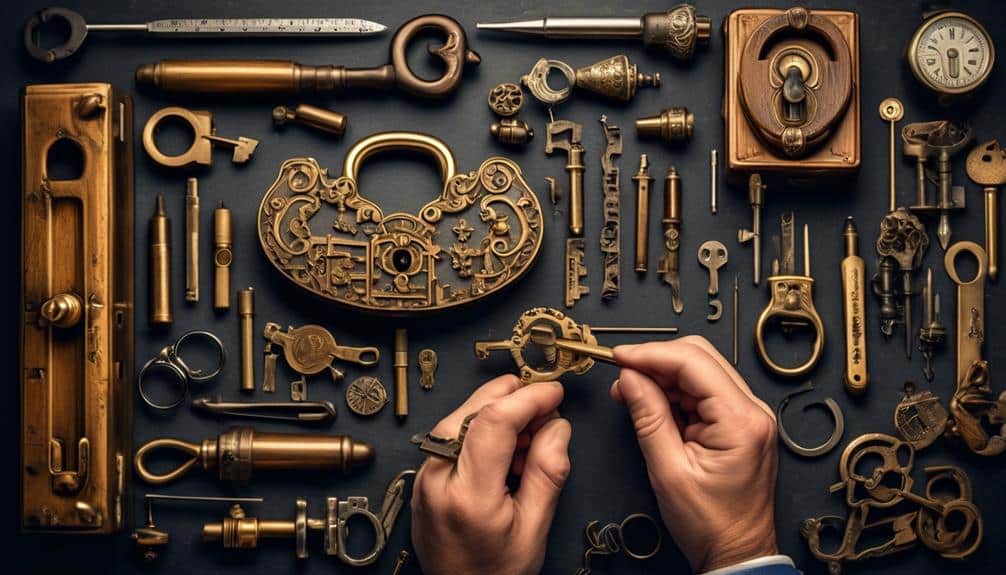
When encountering challenges during the process of duplicating antique lock keys, it's crucial to identify and address the underlying issues to ensure successful replication. Here are four common key duplication mistakes and troubleshooting techniques to overcome them:
- Incorrect key blank: Use the correct key blank for the specific lock type and model. Ensure that the blank matches the original key's shape, size, and grooves.
- Improper alignment: Verify that the original key and the blank are properly aligned in the key cutting machine. Misalignment can lead to inaccurate cuts, resulting in a key that won't work.
- Dull cutting blade: A dull blade can cause jagged or uneven cuts. Regularly inspect and replace the cutting blade to maintain sharpness and precision.
- Incorrect key cutting technique: Follow the manufacturer's instructions carefully when cutting the key. Pay attention to the depth and angle of the cuts to ensure accuracy.
Maintaining the Original Key's Integrity During Duplication
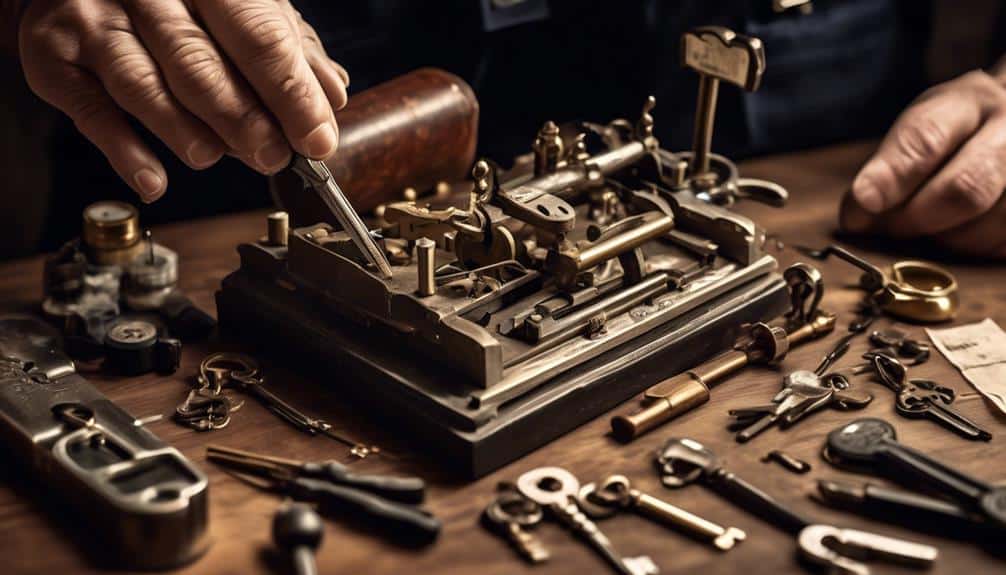
To maintain the integrity of the original key during duplication, it is essential to carefully follow a precise and technical process. This ensures that the duplicated key functions properly and fits seamlessly into the lock. Preventing key duplication mistakes and troubleshooting key duplication errors are crucial steps in this process.
One way to prevent key duplication mistakes is to carefully examine the original key before beginning the duplication process. Look for any signs of wear, damage, or irregularities that could affect the accuracy of the duplication. If any issues are identified, it is important to address them before proceeding with the duplication.
Troubleshooting key duplication errors involves identifying and rectifying any errors that occur during the duplication process. This may include issues such as incorrect key measurements, improper key cutting techniques, or faulty equipment. By carefully analyzing the duplicated key and comparing it to the original, any errors can be identified and corrected.
To further understand the importance of preventing key duplication mistakes and troubleshooting key duplication errors, refer to the table below:
| Key Duplication Mistakes | Troubleshooting Key Duplication Errors |
|---|---|
| Incorrect key measurements | Verify key measurements before cutting |
| Improper key cutting techniques | Ensure proper alignment and cutting technique |
| Faulty equipment | Regularly maintain and calibrate key cutting equipment |
| Failure to compare duplicated key to original | Thoroughly examine duplicated key for accuracy |
Frequently Asked Questions
How Long Does It Typically Take to Duplicate an Antique Lock Key?
On average, duplicating an antique lock key can take anywhere from 30 minutes to a few hours, depending on various factors. These factors include the complexity of the key's design, the condition of the original key, and the skill level of the person duplicating it.
To ensure accuracy, it's important to carefully examine the original key for any unique features or markings. Additionally, using precise measuring tools and following the step-by-step guide can greatly improve the accuracy of the duplication process.
What Are the Common Mistakes to Avoid When Creating a Key Impression?
When creating a key impression, there are common mistakes that we should avoid. One of the most important things is to use proper technique. Improper technique can lead to inaccurate impressions, resulting in a key that doesn't work properly.
It's crucial to ensure that the key blank is properly aligned and seated in the keyway, and that the impression is clear and detailed. Additionally, taking our time and being precise in our movements can help prevent errors in the key duplication process.
Can a Duplicated Key Be Used on Multiple Antique Locks?
Yes, a duplicated key can be used on multiple antique locks, but there are limitations.
While duplicating antique lock keys for modern locks is possible, it may not always work due to differences in technology and security features.
Key duplication techniques for high-security antique locks require precision and attention to detail. It's important to follow a step-by-step guide and use specialized tools to ensure accurate duplication.
Is It Possible to Duplicate a Key if the Original Is Missing or Damaged?
Yes, it's possible to duplicate a key even if the original is missing or damaged.
By creating a key impression without the original key, we can accurately replicate the design and functionality of the original key.
The duplication process involves carefully examining the lock and creating a precise copy of the key based on its unique characteristics.
This ensures that the duplicated key will work seamlessly with the lock, providing a reliable solution for those who've lost or damaged their original key.
How Often Should the Protective Coating on a Duplicated Key Be Reapplied?
When it comes to the protective coating on duplicated keys, the frequency of reapplication depends on various factors. These factors include the type of protective coating used, the level of wear and tear the key is subjected to, and the environment it's exposed to.
Different types of protective coatings have different durability levels, with some requiring more frequent reapplication than others. It's essential to choose a high-quality protective coating that can withstand daily use and provide long-lasting protection for your duplicated keys.

